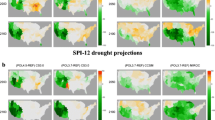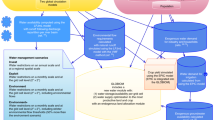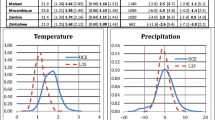Abstract
Are there "thresholds" in greenhouse gas (GHG) concentrations above which associated climate change impacts become economically, socially or environmentally unacceptable? If thresholds exist, then emissions might be limited in such a way that GHG concentrations are not exceeded. Environmental, social, and economic systems should be examined in order to determine these threshold levels.
This paper addressed the potential impacts of climate change on the water resources of the Nile River and associated impacts on the Egyptian economy through the use of a recursively dynamic general equilibrium model. The model was used to examine both economy-wide and sectoral impacts, and impacts on social and national policy indicators under various economic growth and climate change scenarios. Macro-economic indicators such as Gross Domestic Product (GDP) showed that strict economic thresholds, characterized by discontinuities in the response function, did not occur. This was because autonomous economic adjustments generated a smooth socioeconomic transition over the 70-year simulation period. The economy underwent a gradual structural transformation, as capital and resources were moved from cropped agricultural to both the livestock and the non-agricultural sectors. Under "wet" climate scenarios, surplus water beyond 75 billion cubic meters (BCM) remained unused, as the marginal value of water dropped to zero and other resource constraints limited agricultural growth. For drier scenarios (below 75 BCM), water was a constraint to agricultural production into the 21st century, as resources were diverted to less water demanding crops and the livestock and non-agricultural sectors. The reduced water scenarios showed agriculture declining in its total share of GDP, burdening the agricultural wage earner. Egypt increased its dependence on imports to meet food demand, dramatically decreasing grain self-sufficiency, while increasing protein self-sufficiency. If national policy requires a certain level of food self-sufficiency, then these metrics could be used in defining policy-based thresholds.
Similar content being viewed by others
References
Conway, D. and Hulme, M.: 1993, ‘Recent fluctuations in precipitation and runoff over Nile subbasins and their impact on main Nile discharge, Climatic Change 25, 127-151.
El-Din, G.: 1993, ‘It's no bed of flours, say local wheat millers’. Egyptian Gazette (Cairo), 3 October, 1993.
Fischer, G., Frohberg, K., Keyzer, M. and Parikh, K.: 1988, Linked National Models: A Tool for International Food Policy Analysis, Kluwer, Dordrecht, The Netherlands.
Gleick, P.H.: 1991, ‘The vulnerability of runoff in the Nile Basin to climate change, Environmental Professional 13, 66-73.
Hansen, B., 1991: The Political Economy of Poverty, Equity and Growth: Egypt and Turkey, Oxford University Press, New York/Oxford.
Lofgren, H. 1995: Personal communication, American University in Cairo, Cairo, Egypt.
Mellor, J.: 1990, ‘Agriculture on the road to industrialization’, in: C. Eicher, and J. Staatz (eds.), Agricultural Development in the Third World, Johns Hopkins University Press, Baltimore, MA, USA.
O'mara, G.: 1993, ‘Reformulation of the Egyptian Agricultural Sector Model’, (unpublished paper), International Institute for Applied Systems Analysis, Laxenburg, Austria.
Onyeji, C. and Fischer, G.: 1993, ‘An Economic analysis of potential impacts of climate change in Egypt’, Global Environmental Change 4(4), 281-299.
Raskin, P., Gleick P., Kirshen P., Pontius, G., and Strzepek, K.: 1997, Water Futures: Assessment of Long-Range Patterns and Problems, Stockholm Environment Institute, Stockholm.
Riebsame, W.E., Strzepek, K.M., Wescoat, Jr., J.L., Perritt, R., Gaile, G.L., Jacobs, J., Leichenko, R. Magadza, C., Phien, H., Urbiztondo, B.J., Restrepo, P., Rose, W.R., Saleh, M., Ti, L.H., Tucci, C. and Yates, D.: 1995, ‘Complex River Basins’, in: K. Strzepek and J. Smith (eds.), As Climate Changes: International Impacts and Implications, Cambridge University Press, Cambridge, pp. 57-91.
Strzepek, K., Onyeji, C., Saleh, M., and Yates, D.: 1995, ‘An assessment of integrated climate change impacts on Egypt’, in K. Strzepek and J. Smith (eds.), As Climate Changes: International Impacts and Implications, Cambridge University Press, Cambridge, pp. 180-200.
Yates, D.: 1996, ‘Integrating water into an Economic Assessment of Climate Change Impacts on Egypt’, WP-96-31, International Institute for Applied Systems Analysis, Laxenburg, Austria.
Yates, D. and Strzepek, K.: 1996, ‘Modeling economy-wide climate change impacts on Egypt: A case for an integrated approach’, Environmental Modeling and Assessment 1, 119-135.
Yates, D. and Strzepek, K.: 1998a, ‘Modeling the Nile Basin under climatic change’, Journal of Hydrologic Engineering 3(2), 98-108.
Yates, D. and Strzepek, K.: 1998b, ‘An Assessment of integrated climate change impacts on the agricultural economy of Egypt’, Climatic Change 38, 261-287.
Author information
Authors and Affiliations
Rights and permissions
About this article
Cite this article
Strzepek, K.M., Yates, D.N. Responses and Thresholds of the Egyptian Economy to Climate Change Impacts on the Water Resources of the Nile River. Climatic Change 46, 339–356 (2000). https://doi.org/10.1023/A:1005603411569
Issue Date:
DOI: https://doi.org/10.1023/A:1005603411569




